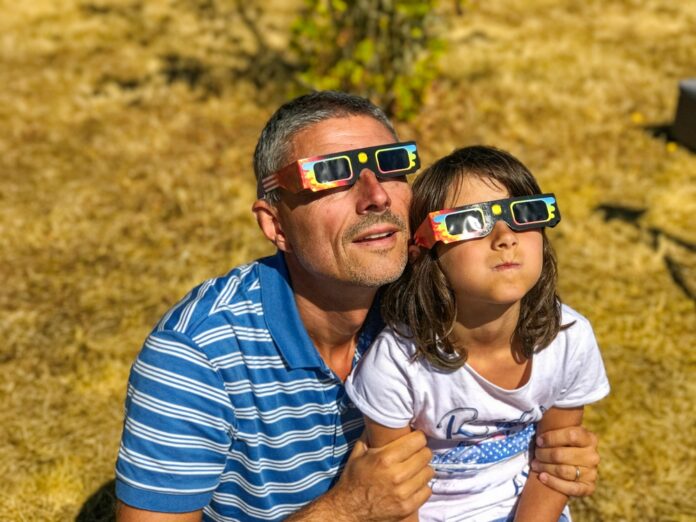Just as Earth revolves around the sun, so too does the moon revolve around Earth. Sometimes, when the angle is just right, the moon slides in front of Earth and ends up completely blocking the sun’s rays: simply put, this is a solar eclipse.
Total solar eclipses look unnatural, like some divine harbinger of misfortune, though they are anything but. They are completely natural phenomena but rare, only occurring once every one to two years over select portions of the globe, drawing crowds of amazed onlookers.
Despite the exotic beauty of seeing a giant circle slowly shade out the sun, solar eclipses should not be viewed by the naked eye. Even though the moon is, quite literally, blocking out all the light, this phase only occurs during a brief period called totality.
Otherwise, the full intensity of the sun’s rays is present and ready to inflict serious damage to sensitive pupils. As such, it is paramount to be smart and safe about how one beholds such spectacles. Here are some helpful pointers and four steps to viewing the solar eclipse safely.
Step 1. Bring the Right Gear
As the moon moves into eclipse position, the sun is still bright and very much unsuitable for direct viewing. To protect your eyes, which have not evolved to gaze directly into the solar glare, it is advisable to use certified solar viewing glasses or handheld viewers. Equipped with special lenses that filter out most of the sun’s light, particularly the ultraviolet and infrared rays, this gazing gear provides adequate visual protection to allow for direct viewing.
Just remember to check that your chosen product meets international safety standards, such as ISO 12312-2:2015. Viewing the eclipse without such lenses or with inadequate protection can immediately result in serious eye injury. That means telescopes, binoculars, and cameras without a specialized filter just won’t cut it.
When totality occurs, and the moon completely obscures our planet’s star, and you can’t see any light from behind your glasses, it is safe to remove protective viewing equipment. However, totality is short-lived, lasting only a few minutes at most, so the moment a sliver of light peaks through, it’s back to being a cautious, bespectacled observer.
Read More: Stunning Total Solar Eclipses Can Damage Your Eyes Without the Right Protection
Step 2. Use a Projector
If you can’t buy solar lenses or specialized viewing devices, you can also indirectly view eclipses by do-it-yourself projectors. With nothing more than cardboard boxes, one can construct a personal pinhole projector, which allows light to pass through from behind the viewer and illuminate a small area in the shape of the projector hole.
With these homemade implements, one can still see the moon slide across the sun, albeit a little indirectly. This is much safer for the eyes and greatly reduces the risk of any sort of optical injury. This makes projection a great alternative to direct viewing, which requires certified equipment to be enjoyed safely.
Experts do not recommend attempting to create your own direct viewing devices or solar lenses without professional input, as these require complex design processes to build properly.
Read More: Maps of Totality for the 2024 Eclipse
Step 3. Make a Plan
Due to the transient and potentially dangerous nature of the eclipse events, it’s important to have a solid itinerary. Do your homework on the timing of the eclipses and the local weather to figure out when and where the event will be most visible. Prime locales will likely be crowded, so it’s good to set up shop early to secure a spot. Bring sunscreen if you can’t find a shady place since you may be standing under the sun for hours as the eclipse comes into view.
Environmental awareness is also key. Eclipses are rare, shading the surroundings in unusual ways, and thus, many animals exhibit strange behavior patterns. Reacting as if nighttime had suddenly set in, birds may prematurely roost, and nocturnal creatures could emerge from their hiding spots. If eclipse-gazing from a nature preserve, it’s important to be mindful of these shifts in wildlife activity.
Read More: 20 Of The Best Places To View The 2024 Total Solar Eclipse
Step 4. Go Remote
Of course, if traveling out to the eclipse just isn’t an option, don’t fret. In the digital age of today, there are numerous innovative technological solutions for experiencing such celestial events. Phone apps and live streams, ideally provided by reputable sources, enable viewing of the eclipse from the comfort of your couch.
These platforms, such as NASA’s Total Eclipse Broadcast, provide high-quality commentary and video, allowing viewers to both enjoy and learn about these rare events. Rest assured that plenty of information and documentation will be available on the Internet, from high-fidelity footage to filtered telescope images providing a magnified view.
Read More: 5 Ways to Enjoy the Solar Eclipse Without Totality
Article Sources:
Our writers at Discovermagazine.com use peer-reviewed studies and high-quality sources for our articles, and our editors review them for accuracy and trustworthiness. Review the sources used below for this article:
Source : Discovermagazine






